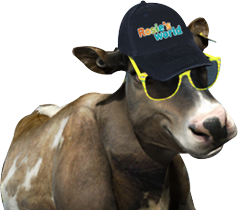Looking for fun facts about milk?
You'll find all you need to know to wow your friends and family right here!

Why is milk white?
Have you ever wondered why milk is white? Our NZ milk is made up of around 85% water. The rest is made up of nutritious vitamins, minerals, proteins, carbohydrates and fats.
Some of the smaller things inside the milk, called particles, are white in colour. Scientists who study chemistry understand all about how matter interacts with energy. One of the things we know from them, is that some particles reflect all light wavelengths.
The water in the milk is transparent, too and it’s this magical combination of transparent and white particles that reflects the light and gives your glass of milk it’s special colour! You may have noticed that different types of milk are slightly different colours. If the milk has less fat, it may have a slightly bluer tone.
Check out our magic milk experiment here to see how milk interacts with other materials such as paint and soap!
Milk Fun Facts:
- Milk is the source of all dairy products!
- Milk is white because it contains casein - a milk protein that is rich in calcium.
- Milk is one of the worlds oldest foods.
- Cleopatra, an ancient Egyptian queen, took milk bath’s to keep her skin looking young and healthy!
- The first milk bottle was invented in 1884, that’s over 130 years ago!
More about milk…
Milk is jam-packed with nutrients and is one of nature's most nutrient-rich foods!
One glass of milk gives you 30% of your daily calcium - a nutrient that growing kids need to form healthy teeth and bones. To get the same amount of calcium that’s in one cup of milk you would need to eat 12 servings of whole grains, 10 cups of raw spinach or 6 servings of legumes!
Milk is an excellent source of vitamins A, B12 and D. These vitamins are essential for healthy eye-sight, nerves, blood and also helps with digestion.
Milk can be grouped into five different types: fresh, concentrated, long-life, raw and powder.
Any bad bacteria are removed from milk when it's pasteurised. Pasteurization is the process of heating up milk and then quickly cooling it down killing any bugs. Raw milk is not pasteurised, but the other types of milk are.
Most milk is also homogenised which means that it has been treated so that the milk fats are spread evenly through the liquid and stops them rising to the top of the bottle.
Milk powder is created when the water is taken out of the milk, a process called evaporation.
Fresh milk can last up to 10 days in the fridge. Long-life milk can last up to six months in a cupboard if unopened. And a sealed packet of milk powder can last up to one year!




